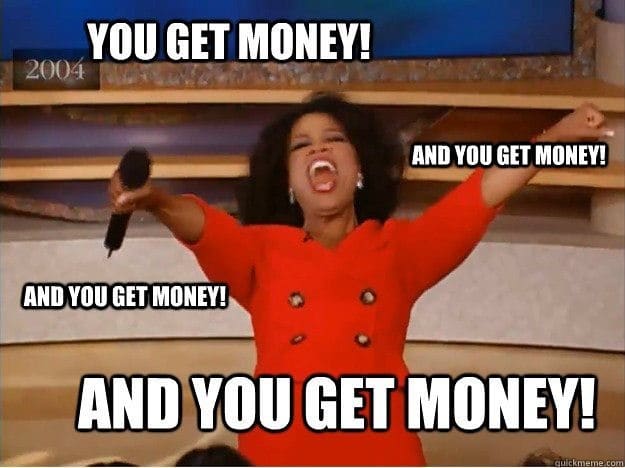By: Bianca Buliga, Content Curator
The Notorious B.I.G’s legendary hip-hop artistry was solidified with his unforgettable hit “Mo Money Mo Problems” – a song many social entrepreneurs WISH they could relate to. Having a few more stacks of cash in the bank can greatly benefit nonprofits on the rise to fame (or you know, breaking even). Cue grant proposals: likely one of the top ten headaches keeping entrepreneurs up late at night.
There’s a LOT of money out there waiting to be claimed – an estimated $50 billion dollars are awarded annually through foundations and corporate grants. If you aren’t applying, you’re missing out on a huge opportunity to earn some extra dough for your venture. Whether you’re lacking the bandwidth, the time, or the patience to start that pesky grant proposal, no worries – you have just come across the Holy Grail of grant-writing guides (minus the hamsters and Elderberries).
Step #1: Read the Grant Application VERY Carefully
Not all grants are created equal. Be sure to read through the instructions thoroughly not once, but TWICE. Highlight questions that must be answered and materials that must be included. Underline the key words and phrases to use, and map out exactly how your venture contributes to the grantor’s overall purpose. At SEED SPOT, we start by making a list of everything required and then asking someone else to verify that our to-do list is complete. Grant proposals require a wide range of fonts, formats, and attachments – it always helps to have an extra pair of eyes.
Step #2: Write a Summary Statement
Some sources call this a summary statement, while others call this an abstract. It’s essentially a one-paragraph description of your request. It outlines the big picture of your proposal, and establishes a few key items including: who you are, what your project is, the amount of money you’re requesting, and how you’ll use that money. This is a great way to organize your thoughts before beginning your outline!
Step #3: Create an Outline
Now, it’s time to expand on each detail in your summary statement. Your outline can vary in format based on your grant’s unique instructions, but the recommended flow is as follows:
- Executive summary (1 page): overview of key information from grant proposal
- Statement of need (2 pages): presents evidence of an existing issue, and shows how your venture will address the problem at hand
- Background information (1 page): explains your venture’s history, governing structure, primary activities, audiences, and contribution to community
- Project description (3 pages): thoroughly details logistics, timeline, anticipated outcomes, evaluation of success, and staffing needs
- Budget (1 page): outlines expenses by category according to your research (not guesswork!) to assure grantor you will spend the money wisely
- Conclusion (2 paragraphs): summarizes the grant proposal’s key points – tell ‘em what you told ‘em!
Step #4: Now Write the Damn Thing
That jumble of disoriented thoughts and musings? Write it down. Start somewhere and put your ideas on paper. Focus on the pieces of your project or venture that you like the most, so that your passion can shine through! Lay out your specific goals, sell your mission, and tell your story. Digging deep and being vulnerable can pay off in a BIG way!

Step #5: Red Ink Everywhere
Go through multiple stages of editing and re-writing. Are your ideas being presented in a clear and concise format? Have you read it out loud to check for proper sentence structure and grammar? Is your story an accurate reflection of self, mission, and venture? Mark it up, go on a track changes spree, and present the best version you can muster!
Step #6: Hand Over the Red Ink to Someone Else
Just when you think you’re done editing, send it off to at least two people you trust to give high-quality feedback! Ensure that at least one of your editors has no idea what your project or venture is about – this will ensure that your ideas are being conveyed with utmost clarity from start to finish. Don’t forget to thank your editors with a handwritten note or cup of coffee!
Step #7: Send off into the World
The step you’ve been waiting for! You finally get to wash your hands of this tedious proposal! But before you click submit, re-read the grant proposal’s instructions to double check that you’ve answered every question, included every necessary attachment, and inserted key words/phrases that will boost your proposal’s pay-off. It would be a huge waste to be disqualified simply because you missed this crucial step.
To make your grant proposal even more professional and polished, you can include:
- A cover letter
- Letters of support from mentors
- Newspaper, magazine, or online articles detailing your milestones
- 501(c)(3) letter of tax exemption
- An audit or financial report
- List of Board of Directors
Step #8: Save Your Work!
You WILL use this information again for different grant proposals. Many organizations ask the same questions, so you can save the basics and tailor for each proposal you submit. Copy your answers into a simple Word document along with the questions from the grant. Bonus points if you can use your answers as excerpts for social media content like a quick and easy tweet!
—
Now that we’ve talked about it, GO DO IT! Take a tremendous step in networking, bringing more attention to your cause, and highlighting your venture’s successes! Remember to follow up within a week or two, and keep your grantor informed of milestones achieved in the meantime. Though funding is not guaranteed, you are now an expert in writing a thorough and professional grant proposal. Stay optimistic, keep applying, and know that your hard work will be worth it in the long run.
Start your entrepreneurial journey today.
Related articles about SEED SPOT:
>>“5 Steps to Building an Impressive Nonprofit Board”
>>“How to Choose the Best Software Development Solution for Your Company”




